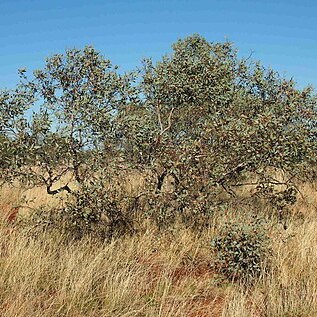Mallee to 4 m. Bark smooth, grey to pink-grey, deciduous in long strips. Juvenile leaves alternate, petiolate, broadly lanceolate, green. Adult leaves alternate, ovate to broadly lanceolate, acuminate; lamina 9–16 cm long, 3–4 cm wide, grey-green; lateral veins faint, at 30°–40°; intramarginal vein up to 1 mm from margin; petiole terete, 15–25 mm long. Umbels 3-flowered; peduncle terete, 5–10 mm long; pedicels 3–6 mm long. Buds globular or subglobular; operculum hemispherical, rostrate, ribbed, 15–20 mm long, 14–17 mm wide; hypanthium hemispherical or obconical, ribbed, 6–7 mm long, 14–17 mm wide. Fruits hemispherical, strongly ribbed, 15–17 mm long, 20–30 mm wide; disc concave, ascending steeply; valves 4 or 5, exserted. Seeds irregularly crescent-shaped, narrowly winged, ribbed on ventral side, red-grey-brown.
More
A shrub. It grows 1-5 m high. It spreads 2-6 m wide. The bark is grey and peels off in long strips. The adult leaves are egg-shaped or broadly sword shaped. They have a long drawn out tip. They are grey-green. The leaves are 9-16 cm long by 3-4 cm wide. The buds are round or cone shaped. They are 6-7 mm long by 14-17 mm wide. The flowers are cream and 4 cm across. They occur in clusters of 3. The capsules are half round and strongly ribbed. They are 15-17 mm long by 20-30 mm wide.
It grows in warm temperate regions. It suits arid or semiarid locations. It needs well drained soil. It can grow in full sun or light shade. It can stand light frosts. It grows in the Gibson and Tanami deserts in Australia. It grows in areas with an annual rainfall above 300 mm. It can grow in arid places. It suits hardiness zones 9-11.
More
Red sand, sandplains, sand dunes, rocky slopes in Western Australia.
Grows onsand plains, sand dunes and rocky slopes in open shrubland.


